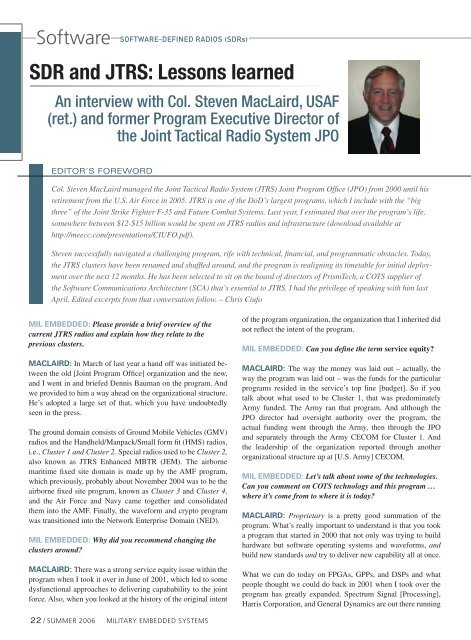Military Embedded Systems Summer 2006
Military Embedded Systems Summer 2006
Military Embedded Systems Summer 2006
You also want an ePaper? Increase the reach of your titles
YUMPU automatically turns print PDFs into web optimized ePapers that Google loves.
Software<br />
Software-Defined Radios (SDRs)<br />
SDR and JTRS: Lessons learned<br />
An interview with Col. Steven MacLaird, USAF<br />
(ret.) and former Program Executive Director of<br />
the Joint Tactical Radio System JPO<br />
EDITOR’S FOREWORD<br />
Col. Steven MacLaird managed the Joint Tactical Radio System (JTRS) Joint Program Office (JPO) from 2000 until his<br />
retirement from the U.S. Air Force in 2005. JTRS is one of the DoD’s largest programs, which I include with the “big<br />
three” of the Joint Strike Fighter F-35 and Future Combat <strong>Systems</strong>. Last year, I estimated that over the program’s life,<br />
somewhere between $12-$15 billion would be spent on JTRS radios and infrastructure (download available at<br />
http://meecc.com/presentations/CIUFO.pdf).<br />
Steven successfully navigated a challenging program, rife with technical, financial, and programmatic obstacles. Today,<br />
the JTRS clusters have been renamed and shuffled around, and the program is realigning its timetable for initial deployment<br />
over the next 12 months. He has been selected to sit on the board of directors of PrismTech, a COTS supplier of<br />
the Software Communications Architecture (SCA) that’s essential to JTRS. I had the privilege of speaking with him last<br />
April. Edited excerpts from that conversation follow. – Chris Ciufo<br />
MIL EMBEDDED: Please provide a brief overview of the<br />
current JTRS radios and explain how they relate to the<br />
previous clusters.<br />
MACLAIRD: In March of last year a hand off was initiated between<br />
the old [Joint Program Office] organization and the new,<br />
and I went in and briefed Dennis Bauman on the program. And<br />
we provided to him a way ahead on the organizational structure.<br />
He’s adopted a large set of that, which you have undoubtedly<br />
seen in the press.<br />
The ground domain consists of Ground Mobile Vehicles (GMV)<br />
radios and the Handheld/Manpack/Small form fit (HMS) radios,<br />
i.e., Cluster 1 and Cluster 2. Special radios used to be Cluster 2,<br />
also known as JTRS Enhanced MBTR (JEM). The airborne<br />
maritime fixed site domain is made up by the AMF program,<br />
which previously, probably about November 2004 was to be the<br />
airborne fixed site program, known as Cluster 3 and Cluster 4,<br />
and the Air Force and Navy came together and consolidated<br />
them into the AMF. Finally, the waveform and crypto program<br />
was transitioned into the Network Enterprise Domain (NED).<br />
MIL EMBEDDED: Why did you recommend changing the<br />
clusters around?<br />
MACLAIRD: There was a strong service equity issue within the<br />
program when I took it over in June of 2001, which led to some<br />
dysfunctional approaches to delivering capabability to the joint<br />
force. Also, when you looked at the history of the original intent<br />
of the program organization, the organization that I inherited did<br />
not reflect the intent of the program.<br />
MIL EMBEDDED: Can you define the term service equity?<br />
MACLAIRD: The way the money was laid out – actually, the<br />
way the program was laid out – was the funds for the particular<br />
programs resided in the service’s top line [budget]. So if you<br />
talk about what used to be Cluster 1, that was predominately<br />
Army funded. The Army ran that program. And although the<br />
JPO director had oversight authority over the program, the<br />
actual funding went through the Army, then through the JPO<br />
and separately through the Army CECOM for Cluster 1. And<br />
the leadership of the organization reported through another<br />
organizational structure up at [U.S. Army] CECOM.<br />
MIL EMBEDDED: Let’s talk about some of the technologies.<br />
Can you comment on COTS technology and this program …<br />
where it’s come from to where it is today?<br />
MACLAIRD: Proprietary is a pretty good summation of the<br />
program. What’s really important to understand is that you took<br />
a program that started in 2000 that not only was trying to build<br />
hardware but software operating systems and waveforms, and<br />
build new standards and try to deliver new capability all at once.<br />
What we can do today on FPGAs, GPPs, and DSPs and what<br />
people thought we could do back in 2001 when I took over the<br />
program has greatly expanded. Spectrum Signal [Processing],<br />
Harris Corporation, and General Dynamics are out there running<br />
22 / SUMMER <strong>2006</strong> <strong>Military</strong> EMBEDDED SYSTEMS
















